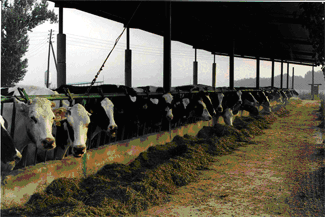Heat stress influences low conception of dairy herds

Reproductive efficiency has suffered a dramatic decrease since the mid 1980s despite rapid worldwide progress in genetics and management of high producing dairy herds. The reasons for the decline in fertility are multifactorial and cannot be solely attributed to an increase in milk production. We propose that summer heat stress is likely to be a major factor related to low fertility in high producing dairy herds, especially in countries with warm weather.
The environmental temperature, radiant energy, relative humidity, and wind speed all contribute to the degree of heat stress. Heat stress may be defined as any combination of environmental variables that give rise to conditions that are higher than those of the temperature range of the animal’s thermal neutral zone. The temperature-humidity index (THI) incorporates the effects of both ambient temperature and relative humidity (RH) in an index. This index is widely used in hot areas worldwide to assess the impact of heat stress on humans and dairy cows.
We analyzed data derived from 10,964 inseminations in 4 herds during 3 years. Climate data such as daily mean and maximum temperature mean and minimum relative humidity, and rainfall were obtained from a meteorological station located less than 6 km away within the herds. Mean and maximum THI were calculated during 7 days before insemination to 3 days postinsemination. Fans are activated when temperature arise at 23-27ºC.
Results indicated that high THI during 3 days before insemination, specially the Day 3 before, reduced fertility, probably due to ovulation failure. Ovulation failure was 3.9 times higher in cows inseminated during the warm period (May-September) compared to the cool period (October-April). THI on the day of insemination is also important for fertility, probably because heat stress could affect oocytes, spermatozoa and embryos. A high maximum temperature on day 1 after insemination was found to reduce conception rate. Although it has been described that hyperthermia in lactating dairy cows can occur at air temperatures as low as 27°C, only maximum daily temperatures <20ºC led to a significant increase in fertility. It should be stressed that in our geographical area, the maximum temperature was only <20ºC for 170 days per year.
As an overall conclusion, climate factors seem to be highly relevant for conception rate. The use of maximum temperatures gives more information that the one provided by THI variables. Thus, the use of the THI or temperature to control a farm environment would depend on the individual farm and on each environmental situation, but it is important to check temperature and humidity to know when to adopt cooling measures. Further studies should try to establish the effect of global warming at the farm level. This problem is reflected with warm summers and even with peaks of temperatures in winter.
Fernando López-Gatius2
References
"Climate factors affecting conception rate of high producing dairy cows in northeastern Spain". Garcia-Ispierto, I; Lopez-Gatius, F; Bech-Sabat, G; Santolaria, P; Yaniz, JL; Nogareda, C; De Rensis, F; Lopez-Bejar, M. THERIOGENOLOGY, 67 (8): 1379-1385 MAY 2007.


